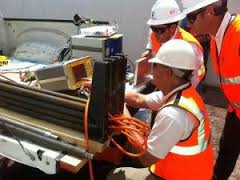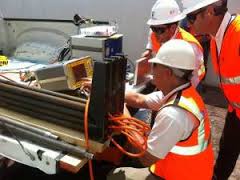Article originally featured on Tradeology, the official blog of ITA (International Trade Administration)
Doug Barry is a Senior International Trade Specialist in the Trade Information Center, U.S. Commercial Service within the International Trade Administration.

John H. Sohl III is founder of Columbia Technologies, a Maryland company that maps underground pollution from large manufacturing facilities, oil terminals, pipelines and military bases. The company is a client of the Baltimore Export Assistance Center.
Barry: How do you map underground pollution?
Sohl: Mapping involves deployment of sensor technologies that track leakage and migration of pollutants. Following analysis by our technicians, customers can make decisions on risk assessment, disposition of the property and proper cleanup actions.
Sohl: I started the company about 15 years ago after doing similar work in the U.S. Navy. I was always intrigued with the application of sensors and three-dimensional mapping of components, and that’s the approach we brought to the industry. The world really is getting flat and many of our clients are global industries that have footprints both in the U.S. and North America as well as the globe. So once we’ve established a good working relationship and reputation with those firms, they sought to bring us into other parts of the globe.
Barry: So your initial market entry strategy was to piggyback on clients here in the U.S. and ride them into new markets.
Sohl: Exactly. And Columbia started closer to home, as many U.S. exporters do. We first migrated up to Canada and performed services up there and sort of cut our teeth on export, and the second, we went down to Mexico and performed the same types of services, and additional services in Mexico. And so that’s been the first two exports in terms of direct boots on the ground, so to speak, of sensors and folks.
Barry: Any additional boots?
Sohl: Yes, in Latin America, including Brazil, Argentina and Colombia. Peru is likely the next target of opportunity. We’re careful not to grow too fast. What’s our capacity as a small business to move into markets? We’re focusing on Latin America at this point in time based on the customer base and the business deals that we can put together in those markets. Next will be Asia but that’s a much more complex world.
Barry: Is employment growing in step with the international business?
Sohl: We’ve grown recently from 10 employees to 13. We expect to double the size of the staff once the Brazil projects are fully underway later this year. International means a lot to us.
Barry: What was the biggest surprise for you in getting out in the world?
Sohl: Well, nothing bad. The biggest is the enthusiastic welcome we as people and our services receive wherever we go. But I think what was really a very pleasant surprise was how eager people were to help us move into those countries and bring the services in there, because a lot of what the technologies that the U.S. companies have are unique in some of these other locations. I was really welcomed with open arms to come down there. The expertise, the experience, the technologies are very important. Yes, I think many of the purchase decisions are made based on the fact that we are bringing to these countries quite a valued proposition.
Barry: Any horror stories with getting paid?
Sohl: I can say, so far, our experience has been nothing but positive. We had very, very little issues with payment terms, and certainly had some slowdowns in moving equipment and things into various countries, but nothing that we didn’t really anticipate.
Barry: Tell us how you got started in Mexico?
Sohl: We had already decided to go to there and then we heard about a trade mission called Trade Winds that was being held that year in Mexico. A major benefit of working with U.S. Commerce was that we attended the Trade Winds expositions, where were connected with a lot of commercial officers from Mexico and throughout Latin America. We got introductions to people who expressed an interest in purchasing our services. We were briefed on Mexican customs regulations and the best methods to get our equipment in and out of the country. So even if I’m visiting on a non-official visit to the Commercial Service side, I’m able to get an audience and gain some help from those people locally based. Being welcomed, being introduced to people in the business community in Mexico was very beneficial for us.
Barry: What’s your advice to companies considering starting to export or expanding to new export markets?
Sohl: Probably the primary piece of advice is don’t feel like you have to do it alone. I mean, the Commercial Service is there to help. Sit down with your local representative, lay out a strategy, think through the strategy and don’t just try to go execute without thinking through all the pieces of the puzzle. Use the resources. Do it very systematically in a very coordinated planning mode. You don’t have to do it as a fire drill. Another lesson is that our competition is foreign. It wasn’t all invented in the U.S. So, yes, there is strong competition from Europe, strong competition from some of the Asian countries and from Australia. We need to understand that it’s not just a U.S. market out there. It’s very much a global market.
Barry: What’s the key to getting repeat business?
Sohl: The international business validates the operating mission of our company, which is its execution. If you do your job well and you provide a good value for a fair price, you’re going to succeed in these countries and with your customers. You can’t fake it. So if you’re going to be in a country and executing in that country, you need to go ready to do the job and do it right.
Once we make the decision to export and entry into a country, we’re going to stay. So we go to build long-term relationships, both with our customers and with our partners. We’re not there on sort of a just drop in, do some work and leave kind of thing. You have to go at it with a long-term perspective.


